Solar eclipse of May 20, 2012
The solar eclipse of May 20, 2012 (May 21, 2012 local time in the Eastern Hemisphere) was an annular solar eclipse that was visible in a band spanning through Eastern Asia, the Pacific Ocean, and North America. As a partial solar eclipse, it was visible from northern Greenland to Hawaii, and from eastern Indonesia at sunrise to northwestern Mexico at sunset. The moon's apparent diameter was smaller because the eclipse was occurring only 32 1/2 hours after apogee.
| Solar eclipse of May 20, 2012 | |
|---|---|
 Composite image taken from Red Bluff, California | |
 Map | |
| Type of eclipse | |
| Nature | Annular |
| Gamma | 0.4828 |
| Magnitude | 0.9439 |
| Maximum eclipse | |
| Duration | 346 sec (5 m 46 s) |
| Coordinates | 49.1°N 176.3°E |
| Max. width of band | 237 km (147 mi) |
| Times (UTC) | |
| (P1) Partial begin | 20:56:07 |
| (U1) Total begin | 22:06:17 |
| Greatest eclipse | 23:53:54 |
| (U4) Total end | 1:39:11 |
| (P4) Partial end | 2:49:21 |
| References | |
| Saros | 128 (58 of 73) |
| Catalog # (SE5000) | 9535 |
A solar eclipse is an astronomical phenomenon that occurs when the Moon passes between Earth and the Sun, thereby totally or partly obscuring the image of the Sun for a viewer on Earth. An annular solar eclipse occurs when the Moon's apparent diameter is smaller than the Sun's, blocking most of the Sun's light and causing the Sun to look like an annulus (ring). An annular eclipse appears as a partial eclipse over a region of the Earth thousands of kilometres wide.
The annular eclipse was the first visible from the contiguous United States since the solar eclipse of May 10, 1994 (Saros 128), and the first in Asia since the solar eclipse of January 15, 2010 (Saros 141).[1] The path of the eclipse's antumbra included heavily populated regions of China and Japan, and an estimated 100 million people in those areas were capable of viewing annularity. In the western United States, its path included 8 states, and an estimated 6 million people were capable of viewing annularity. It was the 58th eclipse of the 128th Saros cycle, which began with a partial eclipse on August 29, 984 AD and will conclude with a partial eclipse on November 1, 2282.
Visibility and viewing

The antumbra had a magnitude of .94, stretched 236 kilometres (147 mi) wide, and traveled eastbound at an average rate of 1.00 kilometre (0.62 mi) per second, remaining north of the equator throughout the event. The longest duration of annularity was 5 minutes and 43 seconds, occurring just south of the Aleutian Islands.[2] The eclipse began on a Monday and ended on the previous Sunday, as it crossed the International Date Line.[1]
Asia
The annular eclipse commenced over the Chinese province of Guangxi at sunrise, at 6:06 a.m. China Standard Time. Travelling northeast, the antumbra of the eclipse approached and passed over the cities of Macau, Hong Kong, Guangzhou, and Xiamen, reaching Taipei by 6:10 a.m NST. After crossing the East China Sea, it passed over much of eastern Japan, including Osaka and Tokyo at 7:28 a.m and 7:32 a.m JST respectively, before entering the Pacific Ocean. The penumbra of the eclipse was visible throughout Eastern Asia and various islands in the Pacific Ocean until noon.[3][4]
The path of the antumbra over highly populated areas allowed at least an estimated 100 million people to view annularity.[5] Because the eclipse took place during the summer monsoon season in Southeast Asia, viewing conditions were not ideal in some areas, including Hong Kong.[6]
North America
After traveling approximately 4,000 miles (6,500 kilometers) across the Pacific Ocean, the antumbra entered North America between the coastlines of Oregon and California, reaching the coastal city of Eureka, California at 6:25 p.m PDT. After passing over Medford, Oregon and Redding, California, it had reached Reno, Nevada by 6:28 p.m PDT. The eclipse continued to travel southeast, passing 30 miles (48 km) north of Las Vegas, Nevada, over St. George, Utah, and reaching the Grand Canyon by approximately 6:33 p.m MST. After passing over Albuquerque, New Mexico and Lubbock, Texas, the eclipse terminated above central Texas at sunset, 8:38 p.m. CST.[3][2][7] An estimated 6.6 million people lived under the path of the antumbra.[8] The penumbra was visible throughout most of North America, including the islands of Hawaii.[2]
Related eclipses
Eclipses of 2012
- An annular solar eclipse on May 20.
- A partial lunar eclipse on June 4.
- A total solar eclipse on November 13.
- A penumbral lunar eclipse on November 28.
Solar eclipses 2011–2014
This eclipse is a member of the 2011–2014 solar eclipse semester series. An eclipse in a semester series of solar eclipses repeats approximately every 177 days and 4 hours (a semester) at alternating nodes of the Moon's orbit.[9][Note 1]
| Solar eclipse series sets from 2011–2014 | ||||||
|---|---|---|---|---|---|---|
| Descending node | Ascending node | |||||
| Saros | Map | Gamma | Saros | Map | Gamma | |
118.jpg.webp) Partial from Tromsø, Norway |
2011 June 01 Partial (north) |
1.21300 | 123 | 2011 November 25 Partial (south) |
-1.05359 | |
128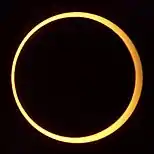 Middlegate, Nevada |
2012 May 20 Annular |
0.48279 | 133.jpg.webp) Cairns, Australia |
2012 November 13 Total |
-0.37189 | |
138 Churchills Head, Australia |
2013 May 10 Annular |
-0.26937 | 143 Partial from Libreville, Gabon |
2013 November 03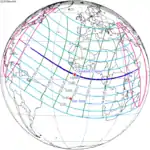 Hybrid |
0.32715 | |
148_cropped.jpg.webp) Partial from Adelaide, Australia |
2014 April 29 Annular (non-central) |
-0.99996 | 153 Partial from Minneapolis |
2014 October 23 Partial (north) |
1.09078 | |
Saros 128
This eclipse is a member of the Solar Saros cycle 128, which includes 73 eclipses occurring in intervals of 18 years and 11 days. The series started with partial solar eclipse on August 29, 984 AD. From May 16, 1417 through June 18, 1471 the series produced total solar eclipses, followed by hybrid solar eclipses from June 28, 1489 through July 31, 1543, and annular solar eclipses from August 11, 1561 through July 25, 2120. The series ends at member 73 as a partial eclipse on November 1, 2282. All eclipses in this series occurs at the Moon’s descending node.
| Series members 52–68 occur between 1901 and 2200 | ||
|---|---|---|
| 52 | 53 | 54 |
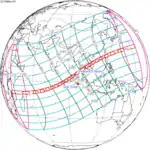 March 17, 1904 |
 March 28, 1922 |
 April 7, 1940 |
| 55 | 56 | 57 |
 April 19, 1958 |
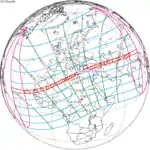 April 29, 1976 |
 May 10, 1994 |
| 58 | 59 | 60 |
 May 20, 2012 |
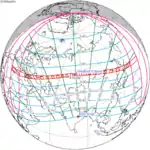 June 1, 2030 |
 June 11, 2048 |
| 61 | 62 | 63 |
 June 22, 2066 |
 July 3, 2084 |
 July 15, 2102 |
| 64 | 65 | 66 |
 July 25, 2120 |
August 5, 2138 (Partial) | August 16, 2156 (Partial) |
| 67 | 68 | |
| August 27, 2174 (Partial) | September 6, 2192 (Partial) | |
Tritos series
This eclipse is a part of a tritos cycle, repeating at alternating nodes every 135 synodic months (≈ 3986.63 days, or 11 years minus 1 month). Their appearance and longitude are irregular due to a lack of synchronization with the anomalistic month (period of perigee), but groupings of 3 tritos cycles (≈ 33 years minus 3 months) come close (≈ 434.044 anomalistic months), so eclipses are similar in these groupings.
| Series members between 1901 and 2100 | |||
|---|---|---|---|
 March 29, 1903 (Saros 118) |
 February 25, 1914 (Saros 119) |
 January 24, 1925 (Saros 120) | |
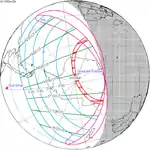 December 25, 1935 (Saros 121) |
 November 23, 1946 (Saros 122) |
 October 23, 1957 (Saros 123) | |
 September 22, 1968 (Saros 124) |
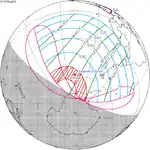 August 22, 1979 (Saros 125) |
 July 22, 1990 (Saros 126) | |
 June 21, 2001 (Saros 127) |
 May 20, 2012 (Saros 128) |
 April 20, 2023 (Saros 129) | |
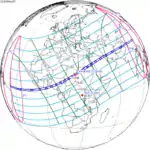 March 20, 2034 (Saros 130) |
 February 16, 2045 (Saros 131) |
 January 16, 2056 (Saros 132) | |
 December 17, 2066 (Saros 133) |
 November 15, 2077 (Saros 134) |
 October 14, 2088 (Saros 135) | |
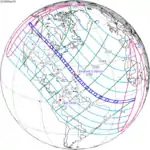 September 14, 2099 (Saros 136) |
|||
Metonic series
The metonic series repeats eclipses every 19 years (6939.69 days), lasting about 5 cycles. Eclipses occur in nearly the same calendar date. In addition, the octon subseries repeats 1/5 of that or every 3.8 years (1387.94 days). All eclipses in this table occur at the Moon's descending node.[10]
| Octon series with 21 events between May 21, 1993 and August 2, 2065 | ||||
|---|---|---|---|---|
| May 20–21 | March 8–9 | December 25–26 | October 13–14 | August 1–2 |
| 98 | 100 | 102 | 104 | 106 |
| May 21, 1955 | March 9, 1959 | December 26, 1962 | October 14, 1966 | August 2, 1970 |
| 108 | 110 | 112 | 114 | 116 |
| May 21, 1974 | March 9, 1978 | December 26, 1981 | October 14, 1985 | August 1, 1989 |
| 118 | 120 | 122 | 124 | 126 |
 May 21, 1993 |
 March 9, 1997 |
 December 25, 2000 |
 October 14, 2004 |
 August 1, 2008 |
| 128 | 130 | 132 | 134 | 136 |
 May 20, 2012 |
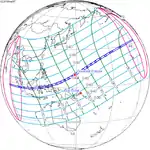 March 9, 2016 |
 December 26, 2019 |
 October 14, 2023 |
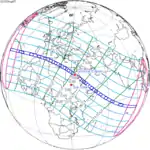 August 2, 2027 |
| 138 | 140 | 142 | 144 | 146 |
 May 21, 2031 |
 March 9, 2035 |
 December 26, 2038 |
 October 14, 2042 |
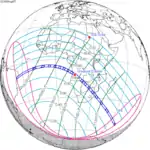 August 2, 2046 |
| 148 | 150 | 152 | 154 | 156 |
 May 20, 2050 |
 March 9, 2054 |
 December 26, 2057 |
 October 13, 2061 |
 August 2, 2065 |
| 158 | 160 | 162 | 164 | 166 |
 May 20, 2069 |
March 8, 2073 | December 26, 2076 | October 13, 2080 | August 1, 2084 |
Inex series
This eclipse is a part of the long period inex cycle, repeating at alternating nodes, every 358 synodic months (≈ 10,571.95 days, or 29 years minus 20 days). Their appearance and longitude are irregular due to a lack of synchronization with the anomalistic month (period of perigee). However, groupings of 3 inex cycles (≈ 87 years minus 2 months) comes close (≈ 1,151.02 anomalistic months), so eclipses are similar in these groupings.
| Inex series members between 1901 and 2100: | ||
|---|---|---|
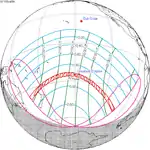 July 20, 1925 (Saros 125) |
 June 30, 1954 (Saros 126) |
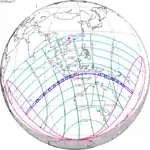 June 11, 1983 (Saros 127) |
 May 20, 2012 (Saros 128) |
 April 30, 2041 (Saros 129) |
 April 11, 2070 (Saros 130) |
 March 21, 2099 (Saros 131) |
||
Notes
- The partial solar eclipses of January 4, 2011 and July 1, 2011 occurred in the previous semester series.
References
- Friedlander, Blaine (May 20, 2012). "Annular solar eclipse first in 18 years in continental United States on May 20". The Washington Post. Archived from the original on July 19, 2012. Retrieved May 20, 2012.
- "Annular Solar Eclipse of 2012 May 20". NASA Goddard Space Flight Center Eclipse Website. NASA. May 20, 2012. Retrieved May 20, 2012.
- "Eclipse Map - May 20–21 Solar Eclipse". TimeandDate.com. Retrieved 20 May 2012.
- Matsutani, Minoru (May 20, 2012). "Tokyo to be treated to rare annular eclipse, Venus transit". The Japan Times. Retrieved 20 May 2012.
- Beatty, Kelly (May 20, 2012). "May 20th's Annular Eclipse of the Sun". Sky and Telescope. Retrieved May 20, 2012.
- "May the Sun Shine on Rare Eclipse". South China Morning Post. May 20, 2012. Retrieved 20 May 2012.
- Potter, Ned (May 20, 2012). "Solar Eclipse Visible From California to Texas Sunday Afternoon". ABC News. Retrieved May 20, 2012.
- Tariq, Malik (May 20, 2012). "Spectacular "Ring of Fire" Solar Eclipse Wows Millions". Space.com. Retrieved May 20, 2012.
- van Gent, R.H. "Solar- and Lunar-Eclipse Predictions from Antiquity to the Present". A Catalogue of Eclipse Cycles. Utrecht University. Retrieved 6 October 2018.
- Note S1: Eclipses & Predictions in Freeth, Tony (2014). "Eclipse Prediction on the Ancient Greek Astronomical Calculating Machine Known as the Antikythera Mechanism". PLOS ONE. 9 (7): e103275. Bibcode:2014PLoSO...9j3275F. doi:10.1371/journal.pone.0103275. PMC 4116162. PMID 25075747.
.jpg.webp)